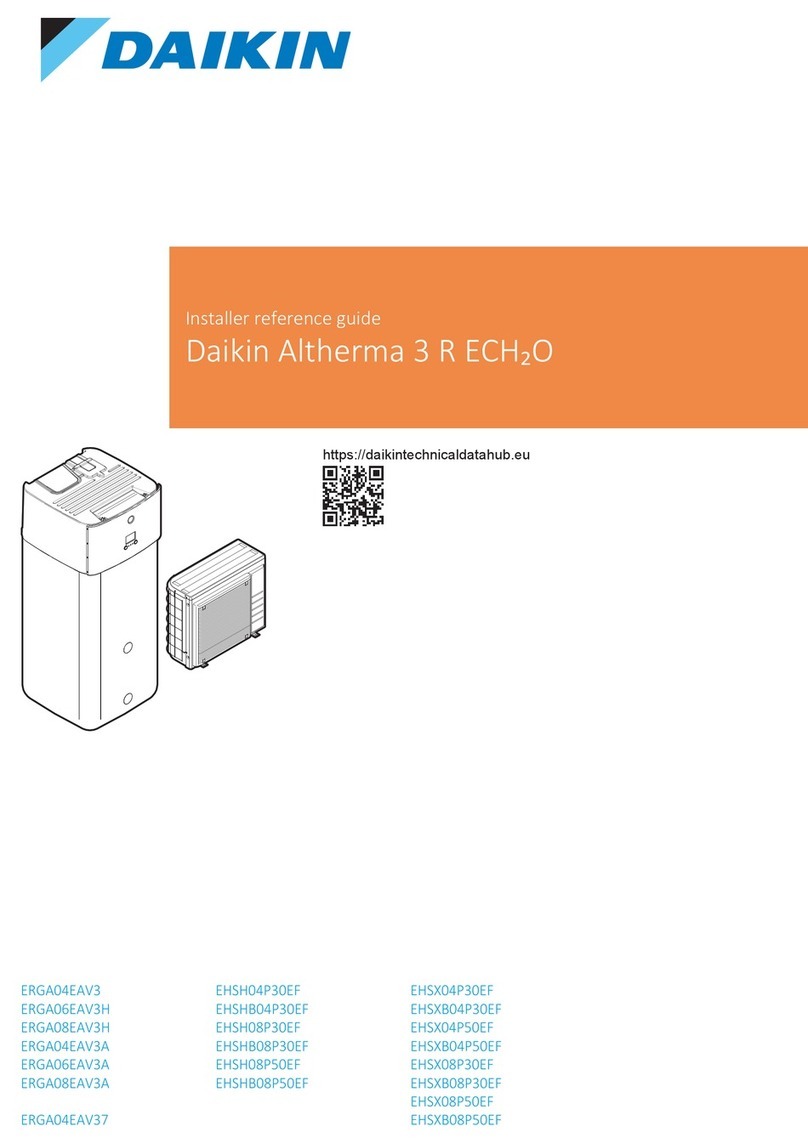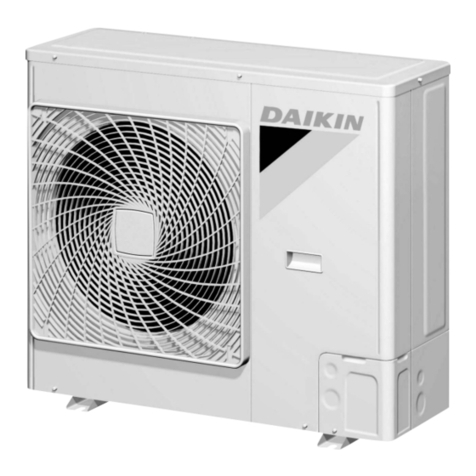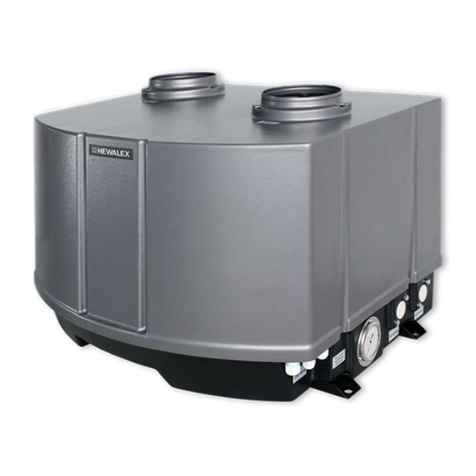CTC Enertech Group GSi 12 Manual

Providing sustainable energy solutions worldwide
Installation and Maintenance Manual
CTC GSi 12
Modulating ground source heat pump
400V 3N~
162 105 78-1 2017-02-13
IMPORTANT
READ CAREFULLY BEFORE USE
KEEP FOR FUTURE REFERENCE

(10 x)
1 2
3
1, 2, 3
1, 2, 3
3
!
162 201 99-1 2015-09-14
1. Disconnect the cooling module’s power cable connector and hoses.
2. Attach the two carrying handles to the bottom of the cooling module.
3. Unscrew the cooling module’s screws. 4. Pull the cooling module by first lifting the front edge
slightly with the carrying handles.
5. Lift the cooling module using the carrying handles and
shoulder straps.
6. Lift the cooling module into the product using the
carrying handles and shoulder straps. Remove the
carrying handles and reconnect the power cable,
hoses and screws.
Removing the cooling module GSi 12
• Any work done on the product’s cooling system should be done by authorised personnel only.
• Close the safety switch before doing any work on the product.

162 105 78-1 2017-02-13
Installation and Maintenance Manual
CTC GSi 12
Modulating ground source heat pump
400V 3N~

4CTC GSi 12
General Information
Table of Contents
Important to remember! _____________________________________________ 6
Your home’s heating installation______________________________ 11
1. Technical data____________________________________________________ 15
Technical data _______________________________________________________ 16
1.1 The envelope CTC GSi 12_______________________________ 17
2. Design ________________________________________________________________ 19
3. Parameter list_____________________________________________________ 20
4. Installation__________________________________________________________ 22
4.1 Transportation _______________________________________________ 22
4.2 Unpacking____________________________________________________ 22
4.3 Scope of delivery ___________________________________________ 22
4.4 Control functions, std. and with expansion card__ 23
5. Pipe installation _________________________________________________ 24
5.1 Schematic diagram ________________________________________ 24
6. Connecting the brine system ____________________________ 35
6.1 Connections _________________________________________________ 35
6.2 Brine system schematic diagram______________________ 38
6.3 Brine pump (G20) __________________________________________ 40
7. Electrical installation _________________________________________ 41
7.1 Sensor connection_________________________________________ 42
7.3 Check connected sensors_______________________________ 43
7.4 Pressure/level switch ______________________________________ 43
7.5 Installing a backup power supply______________________ 43
7.2 Pump Diff thermostat function (G46) on/off ________ 43
7.6 Heating circuit 2 (or cooling) ____________________________ 44
7.7 Pool (accessory) ____________________________________________ 45
7.8 External heat source - EHS _____________________________ 45
7.9 Solar (accessory) ___________________________________________ 46
7.10 Current sensor connection (accessory)______________ 47
7.11 Tank schematic diagram (A2)___________________________ 48
7.12 HP cooling module schematic diagram (A5) _______ 50
7.13 Expansion card (A3) schematic diagram ____________ 52
7.14 Parts list _______________________________________________________ 54
7.15 Resistances for sensors __________________________________ 55
8. First start____________________________________________________________ 56
9. Operation and Maintenance______________________________ 57
9.1 Important information on air bleeding ________________ 58
For the product to work as intended, the system must be
fully bled.______________________________________________________________ 58
10. Menu overview___________________________________________________ 60
11. Detailed menu descriptions ______________________________ 62
11.1 Start menu ___________________________________________________ 62
11.2 Room temperature_________________________________________ 63
11.3 DHW ___________________________________________________________ 65
11.4 Operation _____________________________________________________ 66
11.5 Installer ________________________________________________________ 73
11.6 Heat pump ___________________________________________________ 78
11.7 Electric heater _______________________________________________ 79
11.8 DHW tank_____________________________________________________ 80
11.9 Communication_____________________________________________ 81
11.10 Cooling ________________________________________________________ 81
11.11 Solar panels (accessories) _______________________________ 82
11.12 Diff thermostat function___________________________________ 86
11.13 Pool (accessory) ____________________________________________ 87
11.14 External heat source (EHS)______________________________ 87
11.15 Define system _______________________________________________ 88
11.16 Define remote control _____________________________________ 91
11.17 Remote control procedure_______________________________ 91
11.18 Smart Grid____________________________________________________ 93
11.19 Service_________________________________________________________ 96
12. Troubleshooting/appropriate measures _________ 102
12.1 Information messages ___________________________________104
12.2 Alarm texts __________________________________________________105

5CTC GSi 12

Serial number
6CTC GSi 12
As your own reminder
Fill in the information below. It may come in useful if anything should happen.
Product: Serial number:
Installer: Name:
Date: Tel. no.:
Electrical installer: Name:
Date: Tel. no.:
Enertech AB provides the information with reservation for any typing errors and subject to modification.
Important to remember!
Check the following in particular on delivery and installation:
• The product must be transported and stored in an upright position.
• Remove the packaging and check before installation that the product
has not been damaged in transit. Report any transport damage to the
carrier.
• Place the product on a solid foundation, preferably made of concrete.
If the product needs to be placed on a soft carpet, base plates
must be placed under the adjustable feet.
• Remember to leave a service area of at least 1 metre in front of the
product.
• The product must not be placed below floor level either.
• Avoid placing the heat pump in rooms where the walls are of lightweight
design, as people in the adjoining room may be disturbed by the
compressor and vibrations.

7CTC GSi 12
Congratulations on your new product
You have just bought a CTC GSi 12, which we hope
you will be very pleased with. In the following pages you
can read about how to operate and maintain your heat
pump.
Keep this manual containing the installation and
maintenance instructions. If the heat pump is properly
maintained, you will be able to enjoy the use of your
CTC GSi 12 for many years. This manual will provide all
the information you will need.
The complete heat pump
CTC GSi 12 is a complete heat pump which meets your
home’s heating and hot water requirements. It has a
built-in, energy-efficient (A rated) circulation pump for
connection to the ground/bedrock circuit, i.e. the cold
side. This can be connected to either the left, right or
back of the heat pump, whichever suits you best.
CTC GSi 12 has a control system which:
• Monitors all heat pump functions
• Permits individual settings
• Displays desired values, such as temperatures,
operation times, energy consumption and fault
signals
• Facilitates the setting of values and troubleshooting
in a simple and well-structured way
The built-in heat exchanger provides copious amounts
of hot water. CTC GSi 12 also has a so-called summer-
time basement heating function and a floor heating
block, which maximises the temperature supplied to
the floor circuits. Using the integrated night reduction
function, you can set and change the temperature in the
house during the day, from one day to the next.
Its easily accessible electrical components and cooling
module, along with effective troubleshooting functions in
the control program, make CTC GSi 12 easy to service.
If you want to supplement your CTC GSi 12 with other
sources of heating, you can do this easily. We have
decided to call this option Energyflex. With Energyflex
you can, for example:
• Charge your heating system with solar energy
• Allow a water-jacketed stove to contribute heat
• Connect a pool exchanger to heat up a swimming
pool

Safety instructions
iInformation in this type of box [i] is intended to help ensure that the product
functions optimally.
!Information in this type of box [!] is particularly important for correctly installing and
using the product.
Turn off the power with an omnipolar switch before doing any work on the
product.
The product must be connected to protective earth.
The product is classified as IPX1. The product must not be rinsed with water.
When handling the product with a hoist ring or similar device, make sure that
the lifting equipment, eyebolts and other parts are not damaged. Never stand
under the hoisted product.
Never jeopardise safety by removing bolted covers, hoods or similar.
Any work on the product’s cooling system should be carried out by authorised
personnel only.
The product’s electrical systems should only be installed and serviced by a
qualified electrician.
Safety valve check:
-Safety valve for boiler/system to be checked regularly.
The product must not be started if it is not filled with water; instructions are in
the “Pipe installation” section.
WARNING: Do not switch on the product if there is a possibility that the water in
the heater is frozen.
This device can be used by children from the age of three years and above and
by people with reduced physical, sensory or mental ability or lack of experience
or knowledge if they have been taught, either with supervision or with the
instructions provided, how to use the device safely and understand the risks
involved. Children should not play with the device. Cleaning and maintenance
should not be carried out by children without supervision.
If these instructions are not followed when installing, operating and maintaining
the system, Enertech’s commitment under the applicable warranty terms is not
binding.

9
CTC GSi 12
Your home’s heating installation
iThe set heating curve always takes priority. The room sensor can only increase
or decrease the heat beyond the set heating curve to a certain extent. Where
operating without a room sensor, the selected heating curve determines the
flow temperature supplied to the radiators.
The House Heating Curve
The heating curve is the central part of the product’s control system. It is the heating
curve which determines the compensated flow temperature requirements for your
property dependent upon the outdoor temperatures. It is important that the heating
curve is correctly adjusted, so that you achieve the best operation and economy
possible.
One property requires a radiator temperature of 30°C when the outdoor temperature
is 0°C, whilst a different property requires 40°C. The difference between different
properties is determined by the radiator surface area, the number of radiators and how
well insulated the house is.
Adjustment of Default Values for the Heating Curve
You define the heating curve yourself for your property by setting two values in
the product control system. This is achieved by selecting the options Inclination or
Adjustment under the Installer/Settings/Radiator system menu. Ask your installer to
help you set these values.
It is extremely important to set the heating curve and, in some cases, unfortunately,
this process may take several weeks. The best way of doing this, upon the initial
start-up, is to select operation without any room sensor. The system then operates
using the outdoor temperature reading and the property’s heating curve only.
During the adjustment period it is important that:
• the night reduction function is not selected.
• all thermostat valves on the radiators be fully opened. (This is to find the
lowest curve for the most economical use of the heat pump.)
• the outdoor temperature is not higher than +5°C. (If the outdoor
temperature is higher when the system is installed, use the factory set
curve until the outdoor temperature falls to a suitable level.)
• the radiator system is operational and correctly adjusted between different
circuits.
Appropriate Default Values
During installation you can seldom achieve a precise setting for the heating
curve instantly. In this case, the values given below may provide a good starting
point. Radiators with small heat-emission surfaces require a higher primary flow
temperature. You can adjust the gradient (heating curve gradient) for your heating
system under the Installer/Settings/Radiator system menu.
Recommended values are:
Floor heating only Inclination 35
Low temperature system (well insulated houses) Inclination 40
Normal temperature system (factory setting) Inclination 50
High temperature system
(older houses, small radiators, poorly insulated) Inclination 60

10 CTC GSi 12
Adjusting the heating curve
The method described below can be used to adjust the heating curve correctly.
Adjustment if it is too cold indoors
• If the outdoor temperature is lower than 0 degrees:
Increase the Inclination value by a couple of degrees.
Wait 24 hours to see if any further adjustment is required.
• If the outdoor temperature is higher than 0 degrees:
Increase the Adjustment value by a couple of degrees.
Wait 24 hours to see if any further adjustment is required.
Adjustment if it is too warm indoors
• If the outdoor temperature is lower than 0 degrees:
Decrease the Inclination value by a couple of degrees.
Wait 24 hours to see if any further adjustment is required.
• If the outdoor temperature is higher than 0 degrees:
Decrease the Adjustment value by a couple of degrees.
Wait 24 hours to see if any further adjustment is required.
iIf the values set are too low, this may mean that the desired room temperature
is not being reached. You then need to adjust the heating curve, as necessary,
following the method shown above.
When the basic values have been set more or less correctly, the curve can
be finely adjusted directly using the Room temp. shown on the home menu
screen.

11
CTC GSi 12
Examples of Heating Curves
You can see in the diagram below how the heating curve
changes with different Inclination settings. The gradient of
the curve shows the temperatures that the radiators require
at different outdoor temperatures.
Curve Inclination
The inclination value which is set is the primary flow
temperature when the outside temperature is –15°C.
Primary Flow Temperature
Primary Flow Temperature
Primary Flow Temperature
Outside Temperature
Outside Temperature
Heating off, out
Outside Temperature
Adjustment
The curve can be parallel displaced (adjusted) by the
desired number of degrees to adapt to different systems/
houses.
An example
Inclination 60°C
Adjustment 0°C
In this example, the maximum outgoing primary flow
temperature is set at 55°C.
The minimum permitted primary flow temperature is 27°C
(e.g. summer-time basement heating or the floor circuits in
a bathroom).
Inclination 50°C
Adjustment +5°C
Inclination 50°C
Adjustment 0°C
Heating off, out

12 CTC GSi 12
ºC
ºC
Summer-time operation
All properties have internal heat gains (lamps, oven,
body heat, etc.), which means that the heating can be
switched off when the outdoor temperature is lower
than the desired room temperature. The better insulated
the house is, the earlier the heating from the heat pump
can be switched off.
The example shows the product set at the default value
of 18°C. This value, "Heating off, outside", can be
changed in the Advanced/Settings/Heat System menu.
In systems with a radiator pump, the radiator pump
stops when the heat is switched off. The heating starts
up automatically when it is required again.
Automatic or remote-controlled summer period
The factory setting causes "summer" to commence
automatically at 18ºC, as "Heating mode" is set to
"Auto".
Heating,mode Auto (Auto/On/Off)
Auto means automatic.
On means that the heating is on. For systems with
a mixing valve and a radiator pump, the mixing valve
operates to the primary flow setpoint and the radiator
pump is on.
Off means that the heating is switched off. For systems
with a radiator pump, the radiator pump is switched off.
Heating, ext. mode - (- /Auto/On/Off)
Facility for remote control of whether the heating is to be
on or off.
Auto means automatic.
On means that the heating is on. For systems with
a mixing valve and a radiator pump, the mixing valve
operates to the primary flow setpoint and the radiator
pump is on.
Off means that the heating is switched off. For systems
with a radiator pump, the radiator pump is switched off.
- No selection means no function when activated.
Heating up
Outside Temperature
Heating off, out
Primary Flow Temperature Heating
switched
off

13
CTC GSi 12
1. Technical data
400V 3N~ 50 Hz
kW 5.8
A 2.6
kW 9
kW 0 / 2.1 / 5.2 / 9
A 8.4
IPX1
l 229
bar 3.0
°C 100
l/s 0.28
Wilo Yonos Para RS 25/7,5 PWM1 130
kW 11.8
@ 0/35 | 0/45 | 0/55 kW 6.17 I 5.64 I 5.40 @50 rps
@ 0/35 | 0/45 | 0/55 kW 1.29 I 1.52 I 1.79 @50 rps
COP 1) @ 0/35 | 0/45 | 0/55 - 4.78 I 3.71 I 3.01 @50 rps
@ 5/35 | 5/45 | 5/55 kW 7.16 I 6.62 I 6.36 @50 rps
COP 1) @ 5/35 | 5/45 | 5/55 - 5.69 I 4.31 I 3.57 @50 rps
SCOP 0/35 Pdesign cold climate 2) Pdesign = 11 kW, SCOP = 5.5
SCOP 0/55 Pdesign cold climate 2) Pdesign = 7 kW, SCOP = 4.3
SCOP 0/35 Pdesign average climate 2) Pdesign = 10 kW, SCOP = 5.4
SCOP 0/55 Pdesign average climate 2) Pdesign = 7 kW, SCOP = 4.1
Electrical data
Electrical data
Rated power
Max starting current
Immersion heater (steps of 0,3 kW)
Max immersion heater output
@ fuse size 10 / 16 / 20 / 25 A
Max. operating current Compressor
IP class
Heating system
Water volume (V)
Max. operating pressure boiler (PS)
Max. temperature boiler (TS)
Heating system nominal flow @100 rps
Charge pump
Pressure drop See diagram in chapter Pipe installation
Operational data for heat pump
Max output from compressor
Output from compressor 1)
Input power 1)
1) EN14511:2013, incl. heat medium pump and brine pump
2) SCOP according to FprEN14825

14 CTC GSi 12
Technical data
mm 28
mm 22
mm 22
mm 22
kg 2.4
ton 4.258
MPa 3.1
kg 270 / 253
mm 596 x 1907 x 673
mm 1910
dB(A) Min (20 rps): 35 dB(A)
Max (100 rps): 48 dB(A)
l 4.1
°C -5 / +20
bar 0.2/3.0
l/s 0.29
l/s 0.39
Grundfos UPMXL GEO 25-125
l 1.7
bar 10
°C 100
l 215 / 235 / 311
2.81 (L) / 2.47 (XL) / 2.25 (XL)
Other data
Refrigerant quantity (R407C, fluorinated
greenhouse gases GWP 1774)
CO2equivalent
Interrupt value switch HT
Weight with/without packaging
Width x Height x Depth
Required ceiling height
Noise level (LWA) according to EN 12102 vid 0/35
Brine system
Water volume (V)
Brine system min/max temp (TS)
Brine system min/max pressure (PS)
Brine system min flow
Brine system nominal flow, ∆t=3 K @50rps
Brine pump
Pump capacity See diagram in chapter Pipe installation
DHW system
Water volume (V)
Max operating pressure (PS)
Max operating temperature (TS)
DHW capacity according to. prEN16147 Economic/Normal/Comfort
DHW capacity
COP/ (Tapping cycle)
No annual leakage control of the refrigerant is required
Pipe connections
Brine circuit, ext. diam. Cu piping (flexible hose)
Heating medium, ext. diam. Cu piping
Hot water supply, ext. diam.
Cold water supply, ext. diam.

15
CTC GSi 12
1.1 The envelope CTC GSi 12
The envelope is based on standard rating running conditions, and may
deviate at actual installation.
tci = temperature cold side inlet.(tci = temperatur brine in)
-5
0
5
10
15
20
10
0
20
30
40
50
60
70
tw°C
Water
flow temp (two) °C *)
Water
return temp (twi) °C *)
*)
The envelope is based on standard rating running
tci °C
two
twi
two
twi

16 CTC GSi 12
1. Cold water Ø22
2. Hot water Ø22
3. Radiator return Ø22
4. Primary flow Ø22
5. Expansion connection/ Lifting sleeve G 3/4”
1907
1876
1793
628
673
55
125
596
50
106 137
297
298
1 3 4
5
2

17
CTC GSi 12
Tap water connections
The property’s tap water
connections are connected
here.
Radiator connections
The property’s heating
system is connected here.
DHW heat exchanger
The heat pump is equipped with a
stainless heat exchanger.
Direct heating of hot water
minimises the risk of legionella
bacteria.
Flow heater
This contains a immersion
heater for additional heat.
Diverting valve
Directing the hot water.
Terminal block for sensors
The sensor terminal block
is wired internally. Outdoor
sensors, room sensors and
other sensors are connected
easily here.
Display (A1)
Electrical
connection box
modul (A5)
Tap water pump
Charge pump (G5) for DHW
Electrical connection
box (A2)
Charge pump (G11)
Pump for the hot side (concealed,
placed behind the electrical
connection box) Brine pump (G20)
Circuit breaker (F2)
Circuit breaker (F1)
Max Thermostat (F10)
2. Design
The picture below shows the fundamental construction of the heat pump.
The energy in the bore hole (bedrock) or ground is drawn up by the cooling
system. The compressor then increases the temperature to a usable level.
Afterwards it releases the energy for the heating system and hot water.

18 CTC GSi 12
3. Parameter list
55
18
120
50
0
5
-2
-3
5
1
2
40
90
25
9.0
0
-500
-50
20
3x400V
-60
100
50
58
5
20
58
10
10
4
15
7
3
60
70
5
22
1.0
20
50
1
2
25.0
1
2
Heating circuit Factory
settings
User value
Max primary flow ºC
Min primary flow ºC Off
Heating, mode Auto
Heating, mode, ext Off
Heating off, out ºC
Heating off, time
Inclination ºC
Adjustment ºC
Night reduction disable ºC
Room temp reduced ºC
Primary flow reduced ºC
Alarm room temp ºC
Smart low price ºC
Smart over capacity ºC
Max time heating
Charge pump %
Drying period mode Off
Drying period temp ºC
Electric heater Factory
settings
User value
Max el. heater kW
Max el. heater DHW kW
Start at degree minute
Diff step, degree minute
Main fuse A
Input voltage
Tariff EL Off
Smart block immersion Off
Heat pump Factory
settings
User value
Tariff HP Off
Smart block HP Off
Start at degree minute
Max RPS
Max RPS silent mode
DHW tank Factory
settings
User value
Stop temp °C
Start/stop diff upper ºC
Max time DHW
DHW ºC
Smart low price ºC
Smart overcapacity
Runtime DHW-circ.
Time DHW-circ.
Diff thermostat function Factory
settings
User value
Charge start diff temp ºC
Charge stop diff temp ºC
Charge temperature ºC
External heat source Factory
settings
User value
Charge start ºC
Start/ stop diff.
Smart block cap. Off
Pool Factory
settings
User value
Pool temp °C
Pool diff °C
Max time Pool
Charge pump %
Smart low price ºC
Smart overcapacity ºC
Cooling Factory
settings
User value
Common Heating and Cooling Yes
Condense Secured? No
Room temp cooling
Smart low price ºC
Smart overcapacity

19
CTC GSi 12
60
70
60
70
60
30
18
7
3
60
7
3
20
4 / 30
6.0
120
50
-25
60
70
EcoTank Factory
settings
User value
Charge temperature ºC
Maximum tank temp ºC
X-volume Factory
settings
User value
Charge temperature ºC
Maximum tank temp ºC
Recharging of bedrock Factory
settings
User value
Recharging active No
-Charge start diff temp °C
-Charge stop diff temp °C
-Max brine temperature °C
Charging EHS-tank Factory
settings
User value
Charge start diff temp °C
Charge stop diff temp °C
Charge tank temp °C
Solar panels Factory
settings
User value
Charge start diff temp °C
Charge stop diff temp °C
Charge pump min %
Sensor test active No
-Test/Paus, min
-Winter break No Nov- Feb
Prioritize charging EHS-tank
Flow l/min
Over temp protection panel No
-Max panel temp °C
Cool over temp in tank No
-Tank cooled down to °C
Antifreeze protection panel No
-Active when panel temp °C
Prioritize protection EHS-tank
Settings EHS-tank Factory
settings
User value
Charge temperature ºC
Maximum tank temp ºC
This page is only for
solar panels settings.
List of solar panel parameters

20 CTC GSi 12
Installation
4. Installation
This section is aimed at anyone responsible for one or more of the
installations required to ensure that the product works the way the property
owner wants.
Take your time going through functions and settings with the property owner
and answer any questions. Both you and the heat pump benefit from a user
who has completely understood how the system operates and should be
maintained.
4.1 Transportation
Transport the unit to the installation site before removing the packaging.
Handle the product in the following manner:
• Forklift
• Lifting eye that has been fitted to the lifting sleeve on top of the heat
pump in the expansion connection.
• Lifting band around the pallet. NB: Can only be used with the
packaging on.
Remember that the heat pump has a high centre of gravity and should be
handled with caution.
4.2 Unpacking
Unpack the heat pump when it is placed next to its installation site. Check
that the product has not been damaged in transit. Report any transport
damage to the carrier. Also check that the delivery is complete according to
the list below.
4.3 Scope of delivery
• Heat pump CTC GSi 12
• Filler manifold
• Room sensor
• Outdoor sensor
• 2 x brine hoses
• Installation and Maintenance Manual
• Safety valve for heating system, 2.5 bar (3)
• Safety valve for cold side, 3 bar
• 2 x cable ties
• 2 x support sleeves
• 2 x compression ring couplings for the brine hoses.
• Brine level vessel
• Filter ball valve, magnetite for heating circuit’s return line
• Dirt filter for cold tap water
• Automatic bleeding valve (9)
• Pressure gauge (11)
• Pipe assembly (8)
• Bushing 3/4"x3/8" (10)
!The product must
be transported and
stored in an upright
position.
!As the cooling
module is
removable, there
must be a free
space of at least
one metre in front
of the product and it
must not be placed
below floor level
either.
Table of contents
Popular Heat Pump manuals by other brands
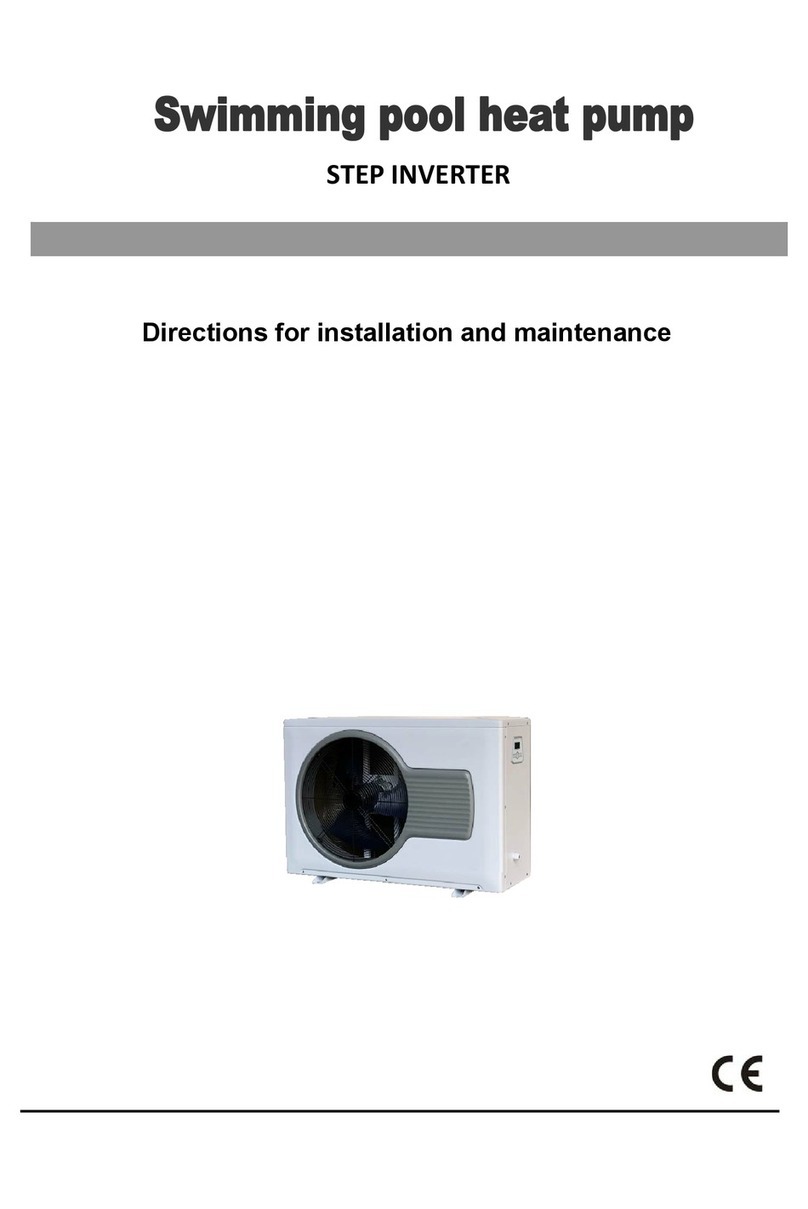
Bridge
Bridge BP-90HS-SI EIP Directions for installation and maintenance

Mitsubishi Electric
Mitsubishi Electric EHST20C-VM2C.UK Service manual

GE
GE ASH220NCDWA Service manual

Panasonic
Panasonic S-22MU1E51 Technical data
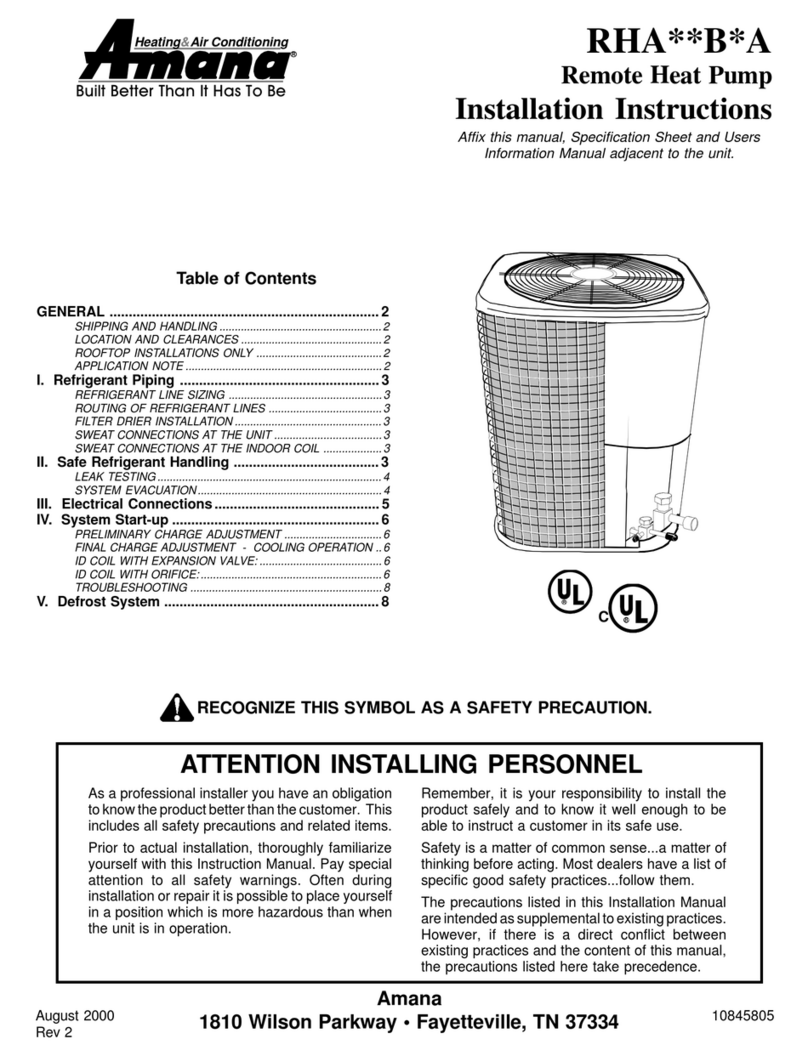
Amana
Amana RHA**B*A installation instructions

Kensa Heat Pumps
Kensa Heat Pumps 7kW Evo Installation and commissioning manual
